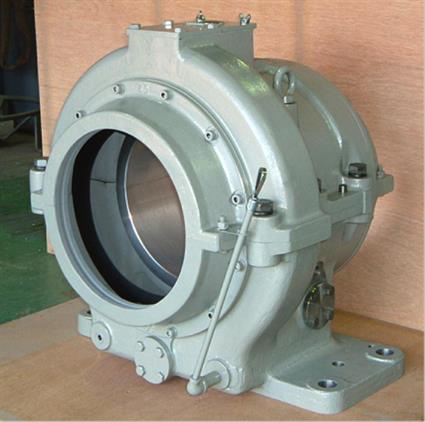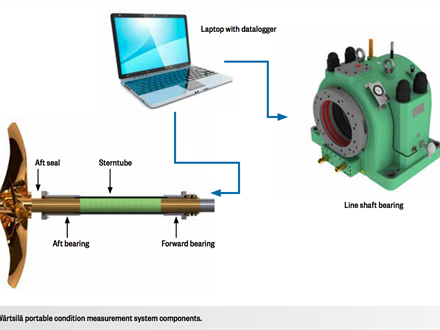By RENÉ BERTELSEN
New Alignment health check can save ship owners millions. Wärtsilä is meeting a growing need in the industry for better alignment services, launching a new portable condition measurement system, and expanding into new regions.
The Wärtsilä portable condition measurement system (CMS), launched in January, is a temporarily installed alignment monitoring solution that allows ship owners and crew to catch, identify, and diagnose shaft positioning and other misalignment issues, while the vessel is operating.
Periodic misalignment issues such as whirling, bedplate twist, and vibration problems are difficult to diagnose. Very often, they are only triggered by very specific conditions: a certain RPM, water depth or load. By the time a service engineer reaches the vessel, the fault has often ceased occurring, returning only after he or she has departed.
Wärtsilä’s portable condition measurement system avoids this problem by logging data on vibration, positioning and other factors over a period of weeks to catch signs of misalignment issues as and when they occur. The equipment and logged data are then dispatched by courier to Wärtsilä’s alignment experts, who analyse the data to diagnose the likely location and nature of the problem.
Ship owners recognise the advantages of the system as a cost-effective way to predict and avoid costly breakdowns and lasting damage. The interest in the market towards this system is already exceeding expectations.
Wärtsilä portable condition measurement system components.
Easy to transport, quick to install
The portable CMS includes a set of vibration, positioning, and proximity sensors, a torque meter, speed pick-ups, temperature sensors, and a strain gauge, all of which are connected by cables to a laptop and data locker.
To prepare for installation, the ship owner first sends over the vessel drawings. Wärtsilä’s engineers can examine the shaft line arrangement and decide in advance where to place the sensors. The crew is then requested to clean the areas where the sensors are to be installed. In some instances, they are also instructed to weld on small brackets to which sensors can be attached. However, the sensors, ranging up to about 5 cm2 in size, can often simply be bolted into place.
The entire system fits inside a briefcase, which can be carried onto the vessel by the superintendent engineer. Depending on the vessel’s size, the system can be installed within four to six hours.
As the shaft cannot be turning when the installation takes place, the engineer either carries out the installation when the vessel is anchored at sea or when it is in port. Vessels with a constant charter can have the equipment mounted while loading or unloading to avoid downtime.
The equipment remains on the vessel to log data for one or more journeys. When the monitoring is complete, the crew removes the equipment as instructed by Wärtsilä’s engineer, packs it into the case and sends it back, usually by courier, to Wärtsilä’s alignment excellence centre.
Vibration sensors – accelerometers similar to those found in a typical smartphone – are positioned to compare vibration levels between two shafts on a vessel or, alternatively, with vibration levels of shafts on a sister vessel. The system records events where vibration levels exceed a pre-set maximum, as well as monitoring how vibration levels change with running conditions, such as whether the vessel is running in shallow or deep waters.
The positioning and proximity sensors, which work by sending out and then retrieving a signal, are placed to monitor how the shaft is moving inside the vessel’s bearings at various speeds, whether it is moving up to one or another, and detecting any ‘whirling’.
The speed pick-up measures rotations per minute (rpm), and the strain gauge measures bend and torque in the shaft itself. The laptop and a specially formatted hard-drive (the data locker), are installed in a cabinet, usually in the vessel’s shaft tunnel room. The cabinet also can be installed with its own display.
If there is a small peak in vibration, an alarm will immediately sound so that acute alignment problems can be addressed before any damage is caused. Wärtsilä staff can then remotely advise crew on how to operate the vessel safely, for example, by keeping within a certain RPM range. This means the vessel can continue trading until its next dry docking.
Once the equipment is returned to the centre of excellence Wärtsilä’s alignment technical support team feeds the collected data into Wärtsilä data management software, generating a status report with recommendations for corrective actions, such as realigning the bearings, engine or gearbox, or even replacing shaft.

Display for the Wärtsilä portable condition measurement system.

Alignment measurement of the propeller shaft using Wärtsilä´s patented gyro laser technology.

Laptop, with datalogger, installed.
Wide range of applications
Although intended initially to diagnose periodic faults, ship owners are fitting the system for a growing number of other purposes: as a precautionary measure to check alignment on new builds immediately after launch; to check for damage when saving fuel by slow steaming with a vessel designed to operate at normal speeds; to collect detailed data on a known fault before going in for repairs; or simply as a routine check-up.
Checking for misalignment issues on new builds is becoming necessary as shipbuilders, rather than manufacturers, increasingly install equipment. As a result, equipment failures on new builds due to misalignment of ship propulsion equipment frequently occur within six months of launch.
Ship owners also nowadays seek to save fuel by slow-steaming their vessels without installing new propeller blades or making other advisable modifications. This can put stress on the shaft and bearings so, before taking the decision, it is sensible for ship owners to first install the portable CMS to check that the cost of damage inflicted is not likely to exceed any savings in fuel.
Collecting data on a known fault can also save valuable time in dry dock by speeding up repairs.
By employing portable CMS, Wärtsilä can provide a detailed status report before the ship is due for dry dock. This allows engineers to plan the repairs, ordering new bearings if there are signs that the bearings have worn out, or make preparations to get a shaft straightened if the problem relates to a bent shaft.
Finally, both the lighter, more efficient equipment on modern vessels and the shift from mineral oil to less forgiving bio-oil demand more precise alignment, making routine check-ups advisable.
Previously, alignment checks were performed by Wärtsilä when the engine was static, using Wärtsilä’s patented gyro laser technology to measure the bending line.
The difference between traditional alignment tests and the new portable CMS is similar to that of performing a stationary electrocardiogram on a heart patient versus sending them out with a portable monitor to record heart activity over 48 hours. The equipment can identify faults that a stationary test cannot.
Common issues detected by the portable CMS include: stern tube bearing failures; stern tube misalignment; shaft bearing failures; shaft bearing misalignment; shaft/coupling/engine or shaft/gear/engine misalignment; main engine bearing failures; main engine misalignment; bedplate twist; and vibration problems.

Image of a line shaft bearing.
Cost effective
Wärtsilä typically leases the portable CMS equipment out, starting from as little as EUR 200 a day, before including the labour and travel cost for the superintendent engineer.
With the bill for a breakdown on a fully-loaded container vessel nowadays frequently running into millions of euros, the leasing fee is a very small price to pay for an early warning of faults developing. Having realised the potential benefits of the portable CMS after using it temporarily to diagnose a fault, several customers have asked to purchase a system to use permanently on their vessels.
The new system’s benefits are also recognised by insurance companies and classification societies. If a ship undergoes repair after a major breakdown, the equipment can be installed for the first few journeys to identify any issues, lowering the risk that they later become liable for post-repair breakdowns.
Traditionally, when a vessel goes out on a sea trial following repairs, engineers have monitored nothing more than the temperature inside the bearings. This often fails to identify continuing issues, such as vibrations, whirling, misplaced load inside the bearing, or stress in the shaft. Installing portable CMS during a sea trial changes this.
A fall in the cost and size of sensors has helped make the new system cost effective, but the primary driver for its introduction has come from the alignment excellence centre technicians who invented it.
Wärtsilä is receiving several enquiries a day for the new system from across the globe, and is responding to this growing demand by hiring dozens of new engineers and training them up to superintendent level.
Did you subscribe for our daily newsletter?
It’s Free! Click here to Subscribe!
Source: Wärtsilä

















